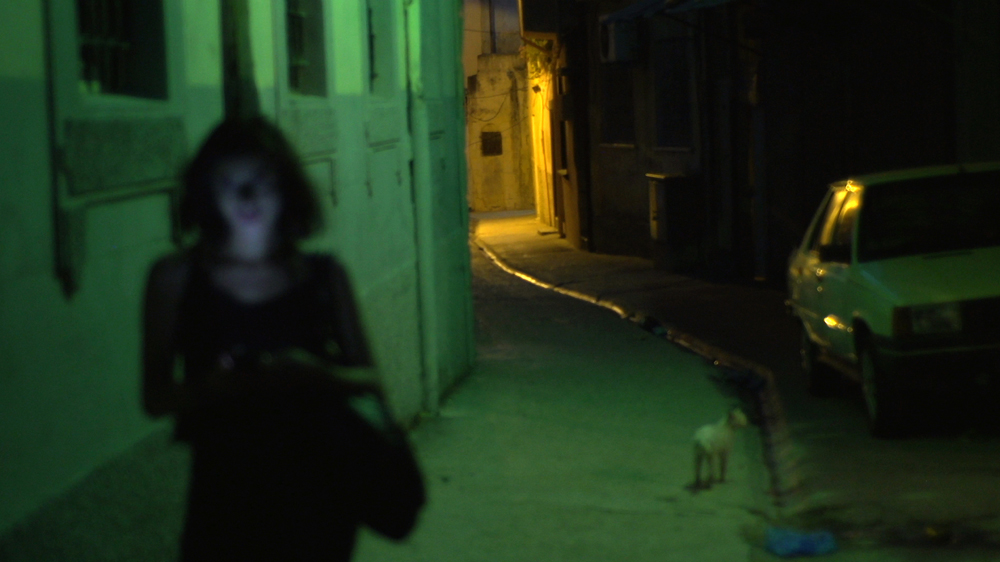If you smirk at the fact that Sophie Deraspe’s “The Amina Profile” has since been retitled “A Gay Girl in Damascus” following its debut earlier this year at the Sundance Film Festival, you’re likely already somewhat familiar with the story of Amina Arraf, the Syrian-based blogger who was thought to be kidnapped after starting the provocatively named blog of the film’s new title. A marketing department couldn’t come up with anything more enticing to news outlets around the world than the “Gay Girl in Damascus” blog, which captured the imagination of millions with the posts of an openly gay woman in the heart of an Islamic state known to punish homosexuality with death. Unfortunately, none of those news organizations bothered to check whether Amina actually existed beyond the digital realm, only realizing that they had been fooled when Jelena Lecic, the woman whose profile picture was used for Amina’s Facebook page, came forward.
Like the blog, Deraspe’s film is immediately enticing, but there is far more beneath the surface, thanks in part to the filmmaker’s friendship with Sandra Bagaria, the woman who encouraged Amina to start a blog after falling in love with her over IM chats and texts. With Bagaria, Deraspe travels the globe to meet in person all the activists and journalists Amina was in contact with, trying to unravel what actually happened and who would perpetrate such a hoax. What the two find – beyond the occasional skepticism from those who wonder if they’re being fooled again – is a fascinating snapshot of activism and newsgathering in the 21st century, detailing how the viral value of a story that people wanted to be true trumped the desire to do the work necessary to actually verify it, in addition to being a compelling personal story of a romance that may have existed only in ones and zeroes as it unfolded, but caused pain that will linger on in the physical world for quite some time.
Fittingly, concurrent with a limited theatrical release, “The Amina Profile” is debuting digitally as part of the SundanceNow Doc Club and coinciding with its opening, Deraspe spoke about how she stumbled into such an interesting subject, coming to documentary from a primarily narrative-based background and what it was like piecing together a real-life mystery.
I am a friend of Sandra Bagaria, so I was a first witness to my friend right next to me experiencing this love story with Amina, [who] hadn’t started the blog [“A Gay Girl in Damascus” yet] – it was encouraged by Sandra actually that she started to publish online, and then all the events that you see in the film [happened]. When Amina was kidnapped and even more when there were questions raised about her identity, I just felt like, “Wow, we’re in the middle of a [movie] trailer here.” For sure, there was a story to tell, but at that point, I didn’t know exactly what kind of film it could be because it was all happening online.
Did it take much convincing to get Sandra to open herself up to filming all her in the midst of this vulnerable situation as she was finding out about it herself?
At first, I told her, “We’re about 30 minutes into the film, Sandra,” and we all knew Sandra was having an online relationship, but when Jelena Lecic called The Guardian to say, “The picture you are publishing is a picture of me, and I have nothing to do with that story,” we knew Amina wasn’t exactly who she pretended to be. Sandra was so involved personally, she was bothered by the media and had to tell the world, “I have never met with her [in person].” She was in turmoil and I didn’t ask her at that time to film her, I just said, “As we film.” I left it like that and she came to me five months afterwards saying, “Sophie, I would like to share our texts with you, so if you think of something to do with it, go ahead.”
At that point, I needed the freedom to dive into the story and expose its complexity and its different levels, and [Sandra] trusted me. It was while researching and thinking about it that I asked her, “Would you come with me meeting with all the people that could tell Amina’s story the way they experienced it?” I felt it would be good for her, seeing that she wasn’t alone in this – that many very bright, intelligent, and educated people were also involved in it and that they would want to meet with Sandra. That’s how we started.
Your first feature, “Missing Victor Pellerin,” was a narrative film was about a con artist, so is it purely coincidental that this film is about deception or is it something you continue to be drawn to?
Yes, in the middle of this investigation around Amina, I really felt like, “Wow, it’s happening to my friend, and I have already questioned all those themes with my first feature film,” so it was weird. I felt like, “How come life is presenting to me a subject like that?” It’s a pure coincidence, but I felt really I was the right person to do it. When the film was shown here in Montreal and Quebec, some people who knew my work felt that it was still I inventing this story. [laughs] Of course, I didn’t. While it had some fiction in it, because Amina is the fantasy that was spread and shared by many, many people, I’m not the one behind it.

At first, I started as a [director of photography], and I did a lot of documentaries. When I shot my first fiction film [“Missing Victor Pellerin”] you have the feeling of a documentary. I really like the documentary language – not only the form, but also the way to direct [subjects]. I really like to put in…can I say it in English, some accidents? [In my narrative work, I] really like to divert the actors from what they thought they would do from the script and put something very new just to disturb them, but they would keep on going in their characters. It’s always in a quest for truth, even while working with actors. Also, I like to shoot in location, in real spaces, so my work as a fiction filmmaker has a lot to do with documentary, and as you saw, my work as a documentary filmmaker has some fiction in it as well.
You come up with a really elegant way to depict social media with text scrolling across the screen as you depict imagined physical interactions in silhouette. That must’ve been a huge challenge to make that interesting for an audience, so how did it come about?
That was a big question at first, wondering if there’s a film to do with all the emails and chats. I thought, “Okay, Amina is a fantasy, and a lot of relationships online are constructed by imagination with words exchanged, but the relationship is real because people do project themselves in it. So I felt that film was quite the right medium to picture this fantasy – it’s built of words and images, in our case, of the Syrian Revolution, of the dangers of being spied on, or by the secret police, by the CIA. Because we have seen [other] films and have access to YouTube, we can all project our self in those situations.
It was quite baroque – a mix of many different things – but I tried to have them all fluid and working all together. We reshot almost every single frame of the YouTube [videos], and the low resolution images that we took from media archives, so we could give them a texture that would mix with the [fictional recreations]. We’re often out of focus, or we focus on specific details to give her this dreamlike impression of what Amina was, and what she was going through.
From what I’ve heard, you were friends with Sandra, but didn’t know her all that well. Was it an interesting parallel to get to know her better through the process of making this with this idea that you can feel as you have a sense of someone online but never truly know them?
Yes, I got to know Sandra quite better by doing the film, and actually, when we first started and it was only the two of us, [with] me doing the camera and sound, I asked her, “Will you do the interviews with the people we need?” Before every meeting we had, she had her own questions, and I had mine, so even if [she asked the questions] in the film, I also had questions for them. By doing it, just the two of us, we could build a trust and we were not a threat to anybody. It also made it really easy for us to move to meet with those people and to get into a very personal relationship [with each other and the subjects]. The trust and friendship there was real, and having a face-to-face encounter with those people, who all experienced that story online in a different part of the world, was quite something. At one point, I thought about conducting the interviews via Skype, then put it in a film and stylize it in a way, but having a face-to-face encounter specifically for this specific story was important.
“A Gay Girl in Damascus: The Amina Profile” is open in Los Angeles at the Laemmle Music Hall and in New York at the IFC Center. It is also available online at the SundanceNow Doc Club.






Comments 1